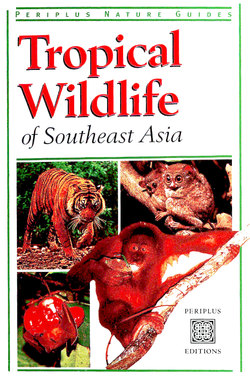Читать книгу Tropical Wildlife - Jane Whitten - Страница 5
На сайте Литреса книга снята с продажи.
ОглавлениеIntroduction
The Southeast Asian countries of Thailand, Malaysia and Indonesia lie within one of the most biologically rich regions on Earth, Glaciers, extensive swamps, savanna, grassy plains, tall mountains and many different types of forest cover this remarkable area. Tropical forests are the dominant natural vegetation and each forest type has its own characteristic species. As a group, these forests are known to harbor one of the most diverse assemblages of wildlife in the world.
Three well-defined zoogeographical realms lie within Southeast Asia: the Oriental region (which extends from Pakistan across southern China, Taiwan, the Philippines and into Indonesia); the Australasian region (reaching from the island of New Guinea, south-east across Australia including New Zealand); and a transitional subregion, known as "Wallacea," located between the two realms (covering central Indonesia). The animals found in the Oriental region are strikingly different from those in the Australasian region, by virtue of the very different geological histories of these regions.
An incredible variety of wildlife occurs in Southeast Asia—altogether about 550 species of mammals, over 500 species of reptiles and over 500 species of amphibians. Some animals, such as bats and geckos, are widespread throughout the region and are easy to find. Other widespread species such as jungle cats, otters and blind snakes can be sighted only with luck and diligence. A few species may be observed only in a single national park which encompasses almost their entire range. Of these, the Komodo dragon is very easy to watch, while it is extremely difficult to catch even a fleeting glimpse of the Javan rhinoceros. Other species with relatively small ranges, such as the anoa, Bawean deer and false ghavial are perhaps best seen in zoos.
The remote areas of Southeast Asia are becoming increasingly accessible as more national parks are developed, and road and air links to them are improved. These national parks, many with excellent interpretive centers, are fostering an increasing awareness and appreciation of the region's unique wildlife. Many species are in danger of extinction through the relentless destruction of forest habitats by logging and land clearance for agricultural and plantation purposes. Land clearance is often facilitated by widespread, damaging fires.
This Periplus Nature Guide covers mammals, reptiles and amphibians and offers an excellent introduction to a wide variety of Southeast Asia's common, well-known species, as well as some of the more extraordinary animals that have evolved in restricted habitats. The region's birdlife, reef fishes and invertebrate marine species are covered in separate volumes in this series.
—Jane Whitten
